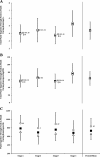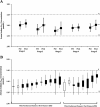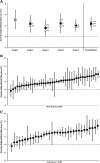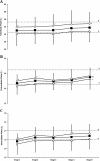Water and sodium intake habits and status of ultra-endurance runners during a multi-stage ultra-marathon conducted in a hot ambient environment: an observational field based study
- PMID: 23320854
- PMCID: PMC3554439
- DOI: 10.1186/1475-2891-12-13
Water and sodium intake habits and status of ultra-endurance runners during a multi-stage ultra-marathon conducted in a hot ambient environment: an observational field based study
Abstract
Background: Anecdotal evidence suggests ultra-runners may not be consuming sufficient water through foods and fluids to maintenance euhydration, and present sub-optimal sodium intakes, throughout multi-stage ultra-marathon (MSUM) competitions in the heat. Subsequently, the aims were primarily to assess water and sodium intake habits of recreational ultra-runners during a five stage 225 km semi self-sufficient MSUM conducted in a hot ambient environment (Tmax range: 32°C to 40°C); simultaneously to monitor serum sodium concentration, and hydration status using multiple hydration assessment techniques.
Methods: Total daily, pre-stage, during running, and post-stage water and sodium ingestion of ultra-endurance runners (UER, n = 74) and control (CON, n = 12) through foods and fluids were recorded on Stages 1 to 4 by trained dietetic researchers using dietary recall interview technique, and analysed through dietary analysis software. Body mass (BM), hydration status, and serum sodium concentration were determined pre- and post-Stages 1 to 5.
Results: Water (overall mean (SD): total daily 7.7 (1.5) L/day, during running 732 (183) ml/h) and sodium (total daily 3.9 (1.3) g/day, during running 270 (151) mg/L) ingestion did not differ between stages in UER (p < 0.001 vs. CON). Exercise-induced BM loss was 2.4 (1.2)% (p < 0.001). Pre- to post-stage BM gains were observed in 26% of UER along competition. Pre- and post-stage plasma osmolality remained within normal clinical reference range (280 to 303 mOsmol/kg) in the majority of UER (p > 0.05 vs. CON pre-stage). Asymptomatic hyponatraemia (<135 mmol/L) was evident pre- and post-stage in n = 8 UER, corresponding to 42% of sampled participants. Pre- and post-stage urine colour, urine osmolality and urine/plasma osmolality ratio increased (p < 0.001) as competition progressed in UER, with no change in CON. Plasma volume and extra-cellular water increased (p < 0.001) 22.8% and 9.2%, respectively, from pre-Stage 1 to 5 in UER, with no change in CON.
Conclusion: Water intake habits of ultra-runners during MSUM conducted in hot ambient conditions appear to be sufficient to maintain baseline euhydration levels. However, fluid over-consumption behaviours were evident along competition, irrespective of running speed and gender. Normonatraemia was observed in the majority of ultra-runners throughout MSUM, despite sodium ingestion under benchmark recommendations.
Figures




Similar articles
-
Perturbed energy balance and hydration status in ultra-endurance runners during a 24 h ultra-marathon.Br J Nutr. 2014 Aug 14;112(3):428-37. doi: 10.1017/S0007114514000907. Epub 2014 May 13. Br J Nutr. 2014. PMID: 24818799
-
Circulatory endotoxin concentration and cytokine profile in response to exertional-heat stress during a multi-stage ultra-marathon competition.Exerc Immunol Rev. 2015;21:114-28. Exerc Immunol Rev. 2015. PMID: 25830597
-
Food intake and electrolyte status of ultramarathoners competing in extreme heat.J Am Coll Nutr. 2002 Dec;21(6):553-9. doi: 10.1080/07315724.2002.10719254. J Am Coll Nutr. 2002. PMID: 12480801
-
Exercise-Associated Hyponatremia in Endurance and Ultra-Endurance Performance-Aspects of Sex, Race Location, Ambient Temperature, Sports Discipline, and Length of Performance: A Narrative Review.Medicina (Kaunas). 2019 Aug 26;55(9):537. doi: 10.3390/medicina55090537. Medicina (Kaunas). 2019. PMID: 31455034 Free PMC article. Review.
-
International Society of Sports Nutrition Position Stand: nutritional considerations for single-stage ultra-marathon training and racing.J Int Soc Sports Nutr. 2019 Nov 7;16(1):50. doi: 10.1186/s12970-019-0312-9. J Int Soc Sports Nutr. 2019. PMID: 31699159 Free PMC article. Review.
Cited by
-
Energy balance of triathletes during an ultra-endurance event.Nutrients. 2014 Dec 31;7(1):209-22. doi: 10.3390/nu7010209. Nutrients. 2014. PMID: 25558906 Free PMC article.
-
Increase in finishers and improvement of performance of masters runners in the Marathon des Sables.Int J Gen Med. 2013 Jun 5;6:427-38. doi: 10.2147/IJGM.S45265. Print 2013. Int J Gen Med. 2013. PMID: 23776392 Free PMC article.
-
Medical services at ultra-endurance foot races in remote environments: medical issues and consensus guidelines.Sports Med. 2014 Aug;44(8):1055-69. doi: 10.1007/s40279-014-0189-3. Sports Med. 2014. PMID: 24748459
-
Gastrointestinal Assessment and Therapeutic Intervention for the Management of Exercise-Associated Gastrointestinal Symptoms: A Case Series Translational and Professional Practice Approach.Front Physiol. 2021 Sep 7;12:719142. doi: 10.3389/fphys.2021.719142. eCollection 2021. Front Physiol. 2021. PMID: 34557109 Free PMC article.
-
The Effect of Gut-Training and Feeding-Challenge on Markers of Gastrointestinal Status in Response to Endurance Exercise: A Systematic Literature Review.Sports Med. 2023 Jun;53(6):1175-1200. doi: 10.1007/s40279-023-01841-0. Epub 2023 Apr 15. Sports Med. 2023. PMID: 37061651 Free PMC article.
References
-
- Maughan RJ, Shirreffs SM. Development of individual hydration strategies for athletes. Int J Sport Nutr Exerc Metab. 2008;18:457–472. - PubMed
-
- Armstrong LE, Casa DJ, Millard-Stafford M, Moran DS, Pyne SW, Roberts WO. American College of Sports Medicine. American college of sports medicine position stand. Exertional heat illness during training and competition. Med Sci Sports Exerc. 2007;39:556–572. doi: 10.1249/MSS.0b013e31802fa199. - DOI - PubMed
Publication types
MeSH terms
Substances
LinkOut - more resources
Full Text Sources
Other Literature Sources
Medical

